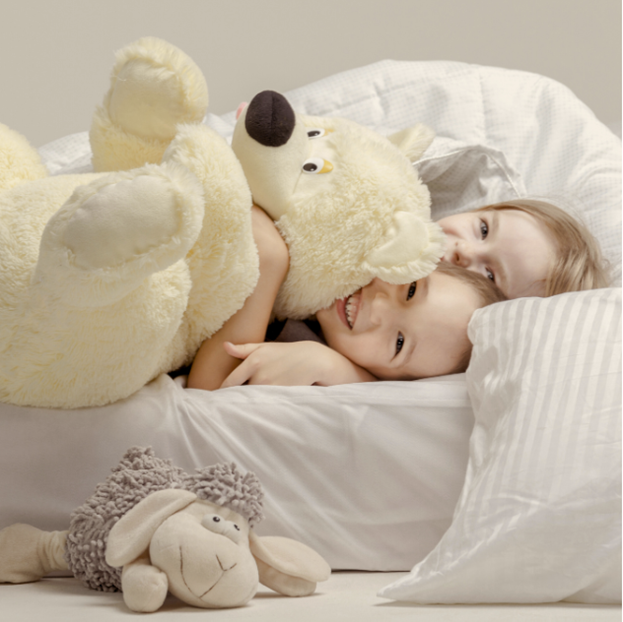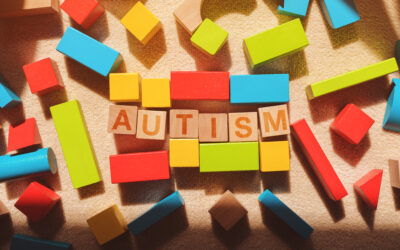By Ally Dube, M.S. BCBA, LABA and Lanna Hecht, M.Ed. BCBA
Published on May 3, 2023
Introduction
If you’re a parent of young children, you’ve likely encountered many nights with little sleep. For parents and caregivers with children with Autism Spectrum Disorder (ASD), sleep challenges can be debilitating. General estimates indicate that up to 80% of children diagnosed with ASD have sleep difficulties (Chen et al., 2021).
Reasons Why Children May Have Trouble Sleeping
Sleep disorders occur for many reasons, and they can manifest in many ways, including:
- delayed sleep onset
- minimal sleep duration
- frequent waking
- rigid sleep behaviors, and
- medical issues.
Children with Autism may struggle with sleep for a variety of reasons, including:
- Environmental Stimuli: Many children with Autism have difficulty processing sensory information, which can make it challenging for them to fall asleep. They may be hypersensitive to stimuli such as noise, light, or touch, or they may seek out sensory input to help them feel calm.
- Anxiety and Stress: Children with Autism may struggle with anxiety or have difficulty regulating their emotions, which can interfere with their ability to fall asleep and stay asleep. They may also have difficulty understanding and coping with changes in routine or unexpected events, which can cause stress and disrupt their sleep patterns.
- Medical Considerations: Children with Autism may have other conditions, such as epilepsy, gastrointestinal issues, or ADHD, which can interfere with their sleep. In addition, medications used to treat these conditions may also affect sleep patterns.
- Sleep Disorders: Children with Autism may also be at higher risk for sleep disorders, such as sleep apnea, restless leg syndrome, or periodic limb movement disorder. These conditions can interfere with the quality of their sleep and make it harder for them to feel rested.
How Can ABA Help with Sleep Issues?
The first step of the assessment process requires the BCBA to collect information from the child’s caregivers regarding the nighttime routine and the child’s sleep habits. Typically, this involves completing an interview, collecting sleep behavior data, and conducting an observation. If the BCBA can’t attend the observation during the child’s nighttime routine, caregivers may consider collecting video clips to share for analysis. If the child has frequent snoring or coughing, or gagging episodes during sleep, it’s recommended that the family seek medical consultation to rule out any underlying medical issues such as sleep apnea, enlarged tonsils/adenoids, or any other condition that may impact the quality and quantity of sleep. Further, if the child is taking any type of medication, a physician may rule out side effects of the medication(s) that impact sleep. Once medical conditions have been ruled out, the BCBA may begin the assessment and treatment of the sleep disorder.
Throughout the assessment process, the caregiver will be asked to keep sleep logs for 1-2 weeks, which record (1) the initial time the child went to bed, (2) the number of times they woke up, (3) what time(s) they woke up, and (4) if they moved to another location such as the caregiver’s bed. Depending on the factors that influence the child’s sleep patterns, the following considerations may be helpful to families.
Problem 1: Delayed Sleep Onset
This variable includes extended durations of time until the child falls asleep. They may go to bed on time but may lay in their bed for hours before falling asleep. This may also include getting in and out of bed frequently and requesting water/food/attention while they’re waiting to fall asleep.
Suggestion:
Use bedtime fading procedures, such as starting the sleep routine later in the evening when you know the child is likely to fall asleep. If your child typically falls asleep at 9:45 PM, begin the sleep fading at 9:30 PM. Once the child consistently falls asleep at 9:30 PM, return to 9:00 PM. Make sure that these sleep time changes occur in small increments of time. The general recommendation is when the child falls asleep within 20 minutes of laying in their bed for 3-5 days, move the bedtime routine back by 15 minutes until the bedtime occurs at a reasonable time.
Problem 2: Frequent Waking
These events occur after the child has fallen asleep for brief periods of time. They may go to sleep at 8:00 PM but wake up at 11:00 PM and 2:00 AM; the problem isn’t falling asleep. It’s staying asleep.
Suggestion:
Caregivers may want to consider using positive reinforcement procedures to reinforce the behavior of staying in bed instead of getting up. Think of ways to make staying IN bed more reinforcing than being OUT of bed. Examples include: purchasing a body pillow or full bed tent, allowing sleep to occur with soothing music that plays all night on a bluetooth speaker, glow-in-the-dark stars on the room’s ceiling, and establishing a consistent sleep schedule. Another suggestion is to set a time threshold before you attend to the child and then increase this time interval gradually. This is called a shaping procedure, where you’re shaping the amount of time the child learns to be alone and can start to engage in behaviors that promote sleep instead of depending on the caregiver to satisfy those needs.
Problem 3: Rigid Sleep Behaviors
These rigid behavior patterns include children setting “rules” about when and where and under what conditions sleeping occurs. Some examples include a child requiring a parent to lie with them, sleeping on specific couches, sleeping with a certain toy or blanket, etc. Without these self-defined rules, the child can’t sleep.
Suggestion:
A shaping process may also be successful in addressing rigid sleeping patterns. Caregivers can agree to stay with the child for longer durations (until they fall asleep) and then slowly decrease the duration they spend with the child. If the child requires the caregiver’s presence, the caregiver can use an air mattress to lay on the floor next to the child for 2 days, then move the air mattress closer and closer to the door until they’re completely faded from the child’s room. The caregiver may also wish to replace their presence with a “comfort” item such as a soft full-body pillow, a large stuffed animal, a piece of their clothing that the child can hold, etc.
Problem 4: Sleeping in Caregiver’s Bed
This happens when the child refuses to sleep in their own bed or will return to the caregiver’s bed throughout the night.
Suggestion:
While it’s easy to allow these behaviors to occur out of exhaustion, remember that what you reinforce today, you will get tomorrow! Each family has their own comfort level with co-sleeping with children, and once you decide on the rules for this, let the child know what you expect. It’s important to always provide positive reinforcement to the child for sleeping in their own bed. Other behaviors to reinforce include calling out to the parent instead of entering their bed. If you don’t want the child to be in your bed at all, when the child enters the bed, calmly return them to their bed and issue a neutral statement such as “This is where you sleep.” It’s critical that caregivers remain calm and neutral during this process. Don’t give the child excessive attention, such as getting a drink of water, reading a book, lying with them for the rest of the night, or other forms of reinforcement. This response will teach the child that staying in their own bed receives MORE reinforcement than going into the caregiver’s bed. Instead provide reinforcement for staying in their own bed, and provide a reward in the morning if they stayed in their bed. Depending on their age and ability to delay gratification, you should eventually fade out the use of daily rewards, so that they need a week of staying in bed to earn a reward.
Top 6 Strategies for Addressing Sleep Issues in Children with Autism
Now that we’ve discussed the suggested recommendations for specific types of sleep behaviors, we will review some general guidelines which promote positive sleep hygiene. These 6 strategies should be used concurrently with the suggestions listed above.
Strategy #1: Bedtime should be calm, quiet, and relaxing.
The lights in the room should be dim, and no screen time should occur in the bedroom. White noise may help to drown out other sensory-related issues.
Strategy #2: Create a cool climate.
Consider how much clothing the child is wearing and the weight of the blankets on the bed. Some children enjoy weighted blankets. However, if they get overheated, this may impact the quality of their sleep.
Strategy #3: Limit drinks, snacks, and rigorous activities 1-2 hours before bed.
Consider quiet activities, such as listening to soothing music or an audiobook through a Bluetooth speaker, taking a bath, or reading a book to your child.
Strategy #4: Develop a consistent bedtime routine that you follow every night.
Create comforting rituals embedded into routine such as stories and lullabies for a positive experience and cherished memories. Children with ASD thrive in highly structured environments. Consider adding visuals such as a visual schedule that depicts the events of the evening prior to bedtime.
Strategy #5: Use positive reinforcement.
ABA techniques, such as positive reinforcement, can encourage the child to engage in desired sleep behaviors. For example, the child might earn rewards for going to bed at the same time every night or for avoiding electronic devices before bedtime.
Strategy #6: Consider a “visual alarm clock”.
These devices provide guidance to children, with visual cues to tell them when to stay in bed and when it is time to get up. An example can be found here: VISUAL ALARM CLOCK
Conclusion
In summary, a BCBA can use the scientific principles of Applied Behavior Analysis to teach families how to promote sleep hygiene. This is accomplished by isolating the variables which impact the behavior into specific components and then targeting each of these components with interventions. Additionally, caregivers may seek professional help from a pediatrician or sleep specialist. With a collaborative approach, the BCBA can work with other members of the child’s medical team to develop a tailored treatment plan.
About Fundamental Development ABA
FUNdamental Development ABA, LLC is an agency specializing in early intervention utilizing the principles of Applied Behavior Analysis. We bring the “fun” back to fundamental life skills. We focus on working with toddlers and preschoolers to maximize this precious window of learning when their brains have the most plasticity and give them the best chance for success later in life. To learn more, visit our website at www.fundamental-aba.com.






